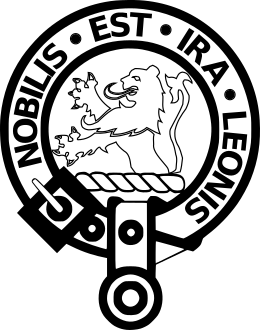Clan Stuart of Bute facts for kids
Quick facts for kids Clan Stuart of Bute |
|
|---|---|
 |
|
| Motto | Nobilis Est Ira Leonis (The Lion's Anger is Noble) |
| Profile | |
| Region | Highland |
| District | Argyll |
| Plant badge | Unknown |
| Chief | |
 |
|
| John Colum Crichton-Stuart | |
| 7th Marquess of Bute | |
| Seat | Rothesay, Argyll and Bute |
The Clan Stuart of Bute is a Highland Scottish Clan. It is a special part of the larger Clan Stewart family. This clan has a long and interesting history, especially on the beautiful Isle of Bute in Scotland.
Contents
History of the Clan Stuart of Bute
How the Clan Started
The first members of the Stewart family came to Scotland from Brittany around the year 1124. They were called "Stewards" or "Seneschals," which were important jobs in charge of a king's household. They quickly became very important in Scotland, known as the High Stewards of Scotland.
Later, a Stewart married Marjorie Bruce, who was the daughter of the famous Scottish king, Robert the Bruce. When Robert the Bruce's only son, David II of Scotland, passed away, the Stewarts became the royal family of Scotland.
King Robert II of Scotland (who was a Stewart) gave his son, Sir John Stewart, the Isle of Bute, the Isle of Arran, and the Isle of Cumbrae. He made these lands into a special area and made his son the "Sheriff" (like a local leader). Another king, Robert III of Scotland, confirmed this gift in 1400.
The 1400s: Early Leaders
John Stewart (1360–1445) was the first Sheriff of Bute. After him, his son, James Stewart, became the second Sheriff. Then came Ninian Stewart, who was confirmed as Sheriff of Bute.
In 1498, King James IV of Scotland gave Ninian Stewart a special honor. He made him the Hereditary Captain and Keeper of Rothesay Castle on Bute. This means the family would always be in charge of the castle. This honor is still held by the family today and is even shown on their coat of arms.
The 1500s: Changing the Name
Ninian Stewart had three marriages. His son, James Stewart, took over in 1539. The family later started spelling their name Stuart instead of Stewart. This French spelling was made popular by Mary, Queen of Scots, and the clan leaders still use it today.
The 1600s: Civil War Times
In 1627, Sir James Stuart of Bute was given the title of "Baronet" by King Charles I of England. This was a special honor. During the Scottish Civil War, Sir James helped the king. He put soldiers in Rothesay Castle and paid for them himself. He was even made a royal leader for western Scotland.
However, things got tough for him. He had to leave Scotland and go to Ireland for a while. When Oliver Cromwell won the war, Sir James Stuart had to pay a large amount of money to get his lands back.
Later, Sir James Stuart's grandson, another James Stuart, supported William of Orange and Queen Mary Stuart becoming king and queen.
The 1700s: Important Leaders and Politics
During the time of Anne, Queen of Great Britain, James Stuart became a very important advisor. He was also made the 1st Earl of Bute in 1703. He helped with talks about Scotland joining with England to form Great Britain. However, he later decided against the union and stopped supporting it.
His son, James Stuart, 2nd Earl of Bute, also held important jobs. During the Jacobite Rising of 1715 (when some people wanted to bring back the old royal family), he led the local soldiers and kept his area peaceful.
The most famous Stuart of this time was John Stuart, 3rd Earl of Bute. He was a teacher to Prince George, who later became King George III. When George became king, the 3rd Earl of Bute became a very powerful person. He was even the Prime Minister of Great Britain and Ireland in 1762! He helped end a big war called the Seven Years' War by signing a peace treaty with France.
His son, John Stewart, later became the 1st Marquess of Bute.
The 1800s: Industry and Castles
John Crichton-Stuart, 2nd Marquess of Bute, was an important member of Parliament. He was also a big business leader who helped build the docks in Cardiff, Wales. These docks became very important for shipping coal. By the time his son passed away in 1900, Cardiff was the biggest coal port in the world!
His son, John Patrick Crichton-Stuart, 3rd Marquess of Bute, was also a business leader. He loved old things and history. He rebuilt two amazing castles, Castell Coch and Cardiff Castle, to look like they did in the Middle Ages. He was given a special honor called a "Knight-Companion of the Most Ancient and Most Noble Order of the Thistle."
The 1900s: Modern Marquesses
John Crichton-Stuart, 4th Marquess of Bute, also loved Architecture and was given the same special honor as his father. His son, John Crichton-Stuart, 5th Marquess of Bute, was an expert in Ornithology (the study of birds).
The next leader was John Crichton-Stuart, 6th Marquess of Bute. He cared a lot about Scottish history and was given a special award for his efforts before he passed away in 1993.
Clan Chief
The current leader of Clan Stuart of Bute is John Bryson Crichton-Stuart, who is the 8th Marquess of Bute.
Clan Castles
The Clan Stuart of Bute has connections to these castles:
See also
- Scottish Clan
- Marquess of Bute
- Clan Stewart, a Scottish Clan, recognized by the Lord Lyon King of Arms, though without a recognized Chief
- Clan Stewart of Appin, a Scottish Clan, recognized by the Lord Lyon King of Arms, though without a recognized Chief
- Clan Stewart of Balquhidder, another branch of the Clan Stewart


